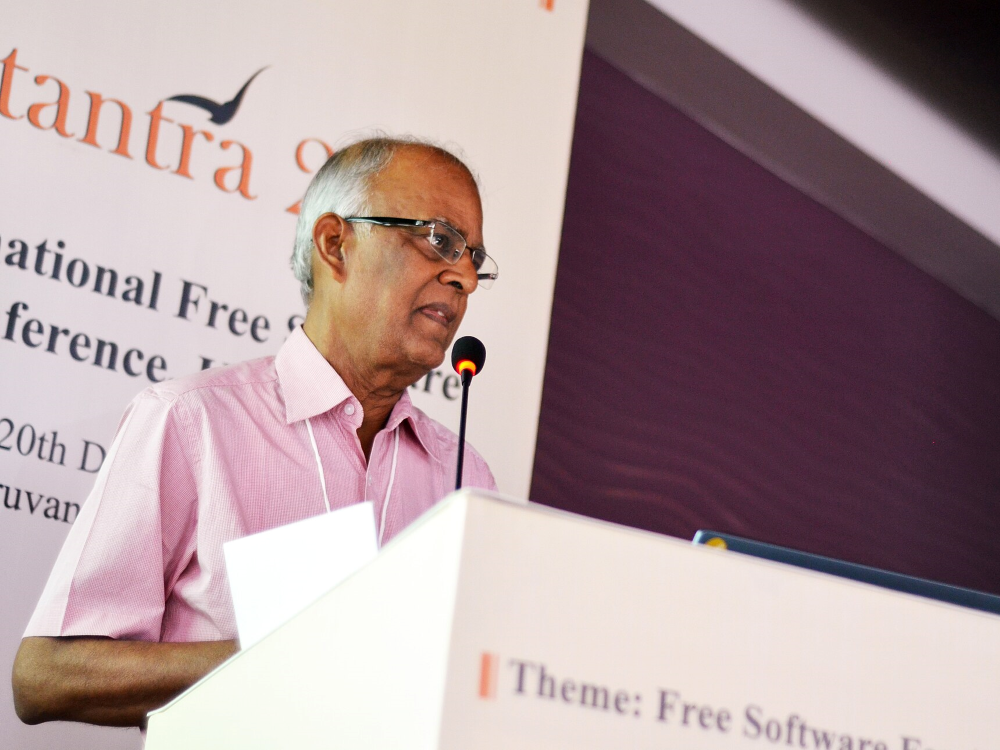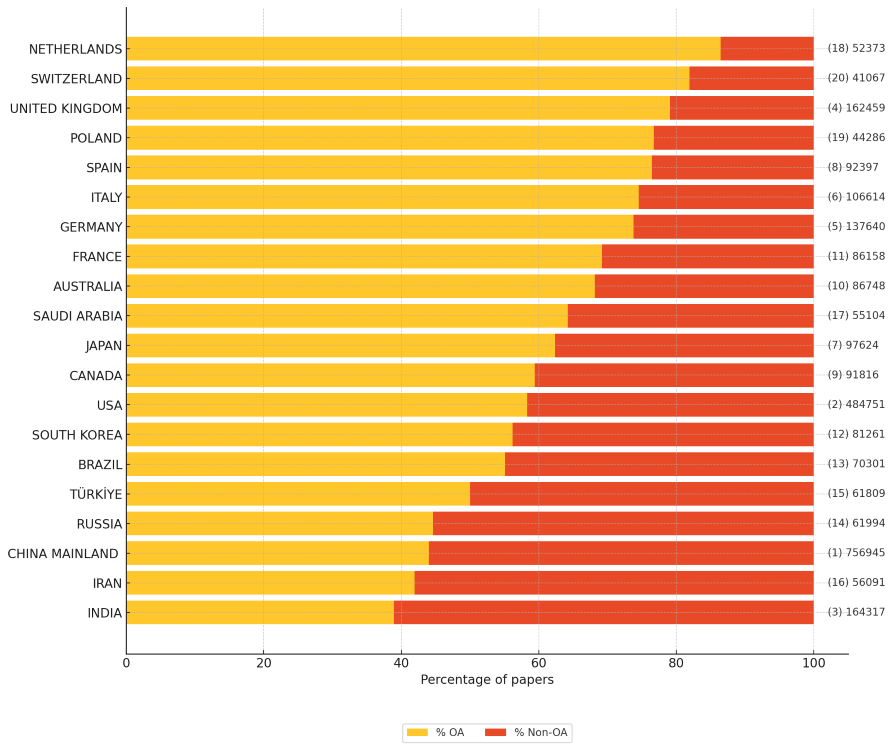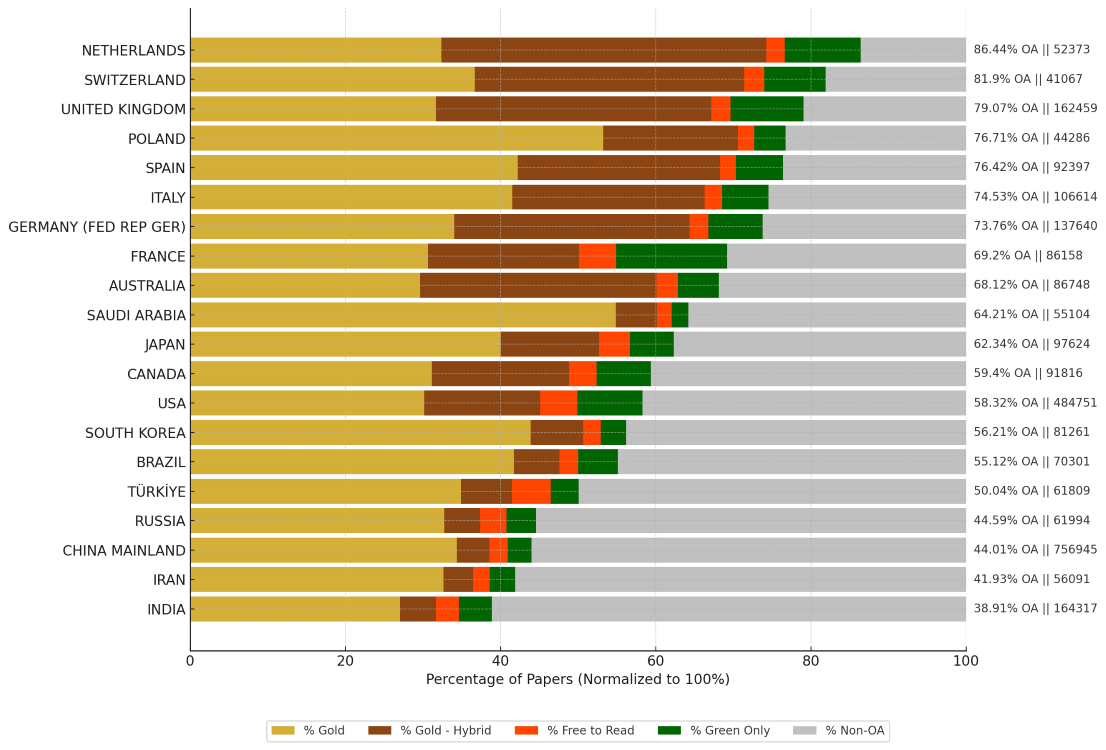It’s Not too Late for Open Access in India
The history of open access in India is rife with missed opportunities. But the current moment offers a chance to learn from global experience and develop a more effective strategy.

The history of open access in India is rife with missed opportunities. But the current moment offers a chance to learn from global experience and develop a more effective strategy.
Open access advocacy in India has been largely a one-man effort by Subbiah Arunachalam, an information scientist interested in scholarly communication, scientometrics, science policy, and information and communication technologies for development (Madhan, 2017; Arunachalam, 2024). For more than 25 years, he has advocated relentlessly for worldwide open access to scientific information. Indeed, he initiated India’s first discussion on the topic, inviting Stevan Harnad, a pioneer in the field, as early as 2000 (Arunachalam, 2001). Arunachalam’s advocacy is motivated by the enduring difficulties faced by researchers in developing countries, particularly India, when it comes to access to information and research visibility (Arunachalam, 1993).
When scholarly communication relied on print media, researchers in India had much less access to scientific information than their counterparts in the United States and Europe. In 1989, Indian neurosurgeon Sunil Pandya wrote in the British Medical Journal about how the rising costs of journals and books often placed them out of reach for students, teachers in medical institutions, and rural or semi-urban doctors in India (Pandya, 1989). Even the best of India’s academic and research libraries typically subscribed to far fewer journals than American and European institutions (The Internet and the Developing World, 1998). Commercial publishers were not interested in distributing medical journals in developing countries, which they did not see as a profitable market (Kale, 1994). Paradoxically, the shift to online journals increased subscription costs, making access less affordable even for institutions in developed countries like the United States (Big Deal Cancellations, n.d.). But the shift also widened the information access gap between research institutions within India and those elsewhere.
Even today, only a limited number of Indian institutions can afford to subscribe to high-quality journals, creating a noticeable divide between these relatively well-funded institutions and most others. The stark differences in library spending across top Indian universities underscores the divide, which is even more pronounced given India’s extensive network of universities and colleges (MoE, 2024).
Recognizing the futility of appealing to the conscience of publishers in an oligopolistic industry, Arunachalam has advocated for open access solutions that operate independently of commercial publishers (Arunachalam, 2017; Arunachalam, 2014). He has championed the self-archiving of research papers in interoperable preprint servers and institutional repositories managed by universities, research institutions, and funding agencies, and advocated for the use of open access journals that do not charge authors or readers (known as diamond open access journals). He has argued on ethical grounds against the practice of authors paying journals to publish their papers.
Several government agencies in India have recognized Arunachalam’s efforts and acted in response to his advocacy. But Arunachalam’s vision for open access in India has yet to become a reality.
First, in 2008 , the Council of Scientific and Industrial Research (CSIR), a network of 37 national research laboratories across India, made all of its journals open access and introduced an open access policy directing its laboratories to establish institutional repositories and requesting its scientists to deposit copies of their post-prints in those repositories. In 2011, CSIR constituted a committee to develop a framework and implement the policy. CSIR’s Unit for Research and Development of Information Products (URDIP) established a shared institutional repository infrastructure for all the CSIR laboratories under CSIRcentral.in. Later, in 2014, the Department of Science and Technology (DST) and the Department of Biotechnology (DBT), two of India’s major public funding agencies, jointly introduced an open access policy that required scientists they funded to share their research papers through institutional repositories. Additionally, the policy required the institutions hosting those scientists to establish an institutional repository to facilitate the immediate self-archiving of post-prints of papers published in journals. URDIP offered assistance to the institutions directly funded by DBT and DST in setting up repositories, leading to the creation of the Sciencecentral.in (which is, along with CSIRcentral.in, currently unavailable due to ongoing upgrades).
Despite a promising start, these policy initiatives faced significant challenges, including inadequate resources, unclear implementation plans, and weak enforcement mechanisms. Without comprehensive support from funding agencies and institutions, they failed to garner compliance from scientists. The complexities of transitioning to open access through interoperable repositories, which would require a cultural shift, became apparent. Consequently, over a decade later, the policies have not been fully implemented.
By the time these policies were initiated, commercial publishers had steered the movement toward author-pay open access journals. Thanks to support from certain funding agencies and governments in the countries where these publishers are based, the author-pay open access model has remained predominant, leaving India and many other developing countries at a disadvantage.
According to an analysis of InCites data as of August 27, 2024, of the more than 2.6 million papers published in 2023 across 21,967 journals, 56 percent are open access. However, only 39 percent of papers with at least one Indian author are open access, giving India the lowest percentage share of open access papers among the top twenty paper-producing countries (See Figure 1). By comparison, more than 70 percent of the papers from the Netherlands, Switzerland, the United Kingdom, Poland, Spain, Italy, and Germany are open access.

In general, countries where governments and funding agencies underwrite publishing costs have higher proportions of open access papers. Open access publishing is concentrated geographically—more than 72 percent of open access papers appeared in journals from Switzerland, the UK, or the USA—and dominated by a handful of commercial publishers. The Multidisciplinary Digital Publishing Institute (MDPI), which runs a large number of author-pay, mega full open access journals, and Springer Nature together account for over 41 percent of the papers that appeared in full open access journals.
Papers authored by Indian researchers appeared predominantly in journals owned by Springer Nature and MDPI, with Elsevier, Wolters Kluwer Medknow Publications, and Frontiers Media SA right behind. The distribution of papers by open access type for the top 20 countries is shown in Figure 2.

Author-pay open access journals have harmful consequences. They have created financial burdens on scientists and perpetuated inequity in the scholarly communication system.
Dhananjaya Sharma, a medical college professor in India, wrote, “The modest salary structures of researchers from low- and middle-income countries (LMICs) and their lack of financial institutional support are too well known to bear repetition, making open access article processing fees an insurmountable barrier to publication” (Sharma, 2021). Offering waivers to scientists by their location, making them seek mercy, is demeaning. As Padmanabhan Balaram, former director of the Indian Institute of Science, put it: “I do not think we should go begging for waivers.” For Balaram, open access through repositories “was a problem-free model” (Jayaraman, 2008). Predatory journals are precisely a product of the author-pay model.
It was significant for India that in 2019, Krishnaswamy VijayRaghavan, then the country’s principal scientific advisor, reversed his decision to join Plan S, an initiative primarily aimed to convert subscription journals to author-pay full open access journals. Plan S ultimately proved counterproductive. With most participating journals failing to flip by the deadline (Silver, 2023), it not only fell short but helped for-profit publishers increase the share of open access papers in hybrid journals through transformative agreements.
However, the alternative VijayRaghavan proposed, One Nation, One Subscription (ONOS), was even more regressive and misguided than Plan S. ONOS involved negotiating with major publishers to impose caps on subscription costs and Article Processing Charges (APCs) at the national level (Poynder, 2019). However, after five years of negotiations, the government has missed the implementation targets twice; the initiative remains stalled, showing its ultimate impracticality.
The Anusandhan National Research Foundation (ANRF), a unified funding body recently established by the Government of India, now includes support for open access publication fees as part of select grants. Using the scarce public funds allocated for scientific research to support author-pay open access is neither inclusive nor sustainable.
The history of open access in India is rife with missed opportunities; however, the current moment offers a chance to learn from global experience and develop a more effective strategy.
A retrospective analysis of open access experiments over the past two decades validates the prescience of Arunachalam’s advocacy. Failures of commercial publisher-centered initiatives underscore the need for community-driven approaches.
The shift by funding agencies like the Bill & Melinda Gates Foundation from allowing author-pay open access to requiring preprint archiving highlights the need for a more strategic and sustainable approach to open access. Indian funding agencies and institutions should motivate scientists to use preprint servers, which have proven to be very effective in scientific communication, to share their findings, rather than relying on the traditional publication lifecycle.
Indian scholarly journals should also adopt preprint archiving as a standard practice and leverage the speed and transparency it offers. Like Discrete Analysis and other overlay journals that add peer review to preprints, Indian journals can build on preprints while maintaining rigorous quality standards. This approach significantly reduces the cost of running a journal.
Recently, the US and Japan, two major science-producing nations, have wisely decided to make their publicly funded research openly accessible through interoperable repositories by 2025 (Singh Chawla, 2024; Nelson, 2022). India should advance a similar policy—this time with a proper resource commitment to ensure successful implementation. Without delay, India should implement INDSTA, the interoperable open-access portal for publicly funded research outputs, as proposed in the Science, Technology, and Innovation Policy (STIP) in 2020.
ANRF should recognize and fully support diamond open access journals run by Indian scholarly societies to sustain their mission. These journals, such as the Indian Journal of Medical Ethics, are run by dedicated communities and have earned international respect defying metrics like “impact factor” (Marcus, 2016).
Finally, India should consider two models that, as Arunachalam recently put it, “follow the Gandhian ideal of trusteeship”: Subscribe to Open (S20) and Direct to Open, developed by Annual Reviews and MIT Press, respectively.
(Note: Annual Reviews is the publisher of Katina.)
“As the third-largest producer of scientific papers and with aspirations to become a scientific superpower,” Arunachalam writes, “it is only fair that India sponsors such initiatives, as well as supports earlier efforts like arXiv” (Arunachalam, 2024).
Arunachalam, S. (1993). Serials and developing countries: Use of serials literature. In Woodward, H. and Pilling, S. (Eds): The Serials Industry. Gower.
Arunachalam, S. (2001). Advances in Information Access and Science Communication. Current Science, vol. 80, no. 4, 2001, pp. 493–94. https://www.jstor.org/stable/24104234
Arunachalam, S., et al. (2014, December). “Heads I Win, Tails You Lose: The Intransigence of STM Publishers.” Proceedings of the Indian National Science Academy, vol. 80, no. 5, p. 919. https://doi.org/10.16943/ptinsa/2014/v80i5/47965
Arunachalam, S. (2017). “Mr Open Access”, Tells Us Why Policy Research Is Important – Connect with IISc. https://connect.iisc.ac.in/2017/04/why-policy-research-is-important-a-qa-with-subbiah-arunachalam/
Arunachalam, S. (2017). Social Justice in Scholarly Publishing: Open Access Is the Only Way. The American Journal of Bioethics, vol. 17, no. 10, pp. 15–17. https://doi.org/10.1080/15265161.2017.1366194
Arunachalam, S. (2024). “A webinar of interest to STEM librarians.” [Online forum post]. LIS-Forum. https://ncsi.iisc.ernet.in/archives/list/[email protected]/thread/L3RLLYSAJLOSRCEMRFWMCGRQHO2EKSKO/
Big Deal Cancellations. Retrieved August 22, 2024, from https://bigdeal.sparcopen.org/cancellations
Government of India, Ministry of Science & Technology, & Department of Science & Technology. (2020). Science, Technology, and Innovation policy. In Draft STIP Doc 1.4.
The Internet and the Developing World. (1998.) https://wgbis.ces.iisc.ac.in/envis/doc97html/infoarun422.html
Jayaraman, K.S. (2008.) Q&A: Open Archives — the Alternative to Open Access. SciDev.Net, https://www.scidev.net/global/features/q-a-open-archives-the-alternative-to-open-access/
Kale, R. (1994). Health Information For The Developing World. BMJ: British Medical Journal, vol. 309, no. 6959, 1994, pp. 939–42. https://www.jstor.org/stable/29725054
Madhan, M. (2017, March 17). A Global View of Open Access (6): A Perspective from India. Tonyhey.Net. https://tonyheynet.com/2017/03/10/a-global-view-of-open-access-6-a-perspective-from-india/
MoE, National Institute Ranking Framework (NIRF). Retrieved August 22, 2024, from https://www.nirfindia.org/Rankings/2024/UniversityRanking.html
Nelson, A. (2022, August 25). Memorandum for the Heads of Executive Departments and Agencies: Ensuring Free, Immediate, and Equitable Access to Federally Funded Research. United States. Executive Office of the President and United States. Office of Science and Technology Policy. https://rosap.ntl.bts.gov/view/dot/65799
Pandya, S. (1989). Coping with the medical literature. BMJ: British Medical Journal, vol. 299, no. 6694, 1989, pp. 333–333. https://www.jstor.org/stable/29704906
Poynder, R. (2019, October 31). The OA Interviews: K. VijayRaghavan, Principal Scientific Adviser, Government of India. Open and Shut? https://poynder.blogspot.com/2019/10/the-oa-interviews-k-vijayraghavan.html
Sharma, D. (2021). A call for reforms in global health publications. The Lancet Global Health, 9(7), e901–e902. https://doi.org/10.1016/S2214-109X(21)00145-5
Silver, A. (2023, June 21). 68% of ‘transformative journals’ to be kicked out of Plan S scheme - Research Professional News. Research Professional News. https://www.researchprofessionalnews.com/rr-news-europe-infrastructure-2023-6-68-of-transformative-journals-to-be-kicked-out-of-plan-s-scheme/
Singh Chawla, D. (2024, May). Japan’s Push to Make All Research Open Access Is Taking Shape. Nature. https://doi.org/10.1038/d41586-024-01493-8
Wolters Kluwer Health Acquires Medknow. (2011, December 7). Reuters. https://www.reuters.com/article/business/healthcare-pharmaceuticals/wolters-kluwer-health-acquires-medknow-idUSDEE7B608U/
10.1146/katina-111024-1
Copyright © 2025 by the author(s).
This work is licensed under a Creative Commons Attribution Noncommerical 4.0 International License, which permits use, distribution, and reproduction in any medium for noncommercial purposes, provided the original author and source are credited. See credit lines of images or other third-party material in this article for license information.